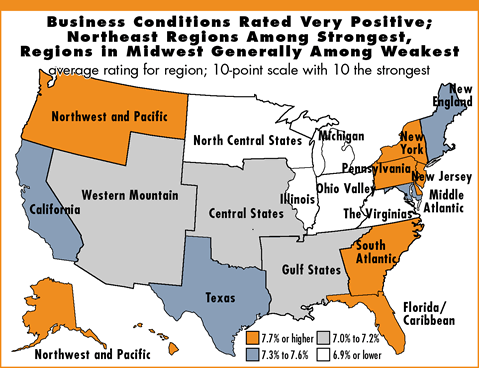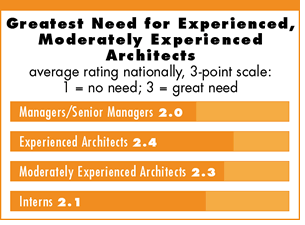

12/2005
AIA component leaders report healthy conditions for all major construction sectors, and a growing need for architect positions
by
Kermit Baker, PhD, Hon. AIA
AIA Chief Economist
Business conditions are very favorable for architecture firms, with leaders in every AIA region rating them as at least reasonably strong, and most rating them very strong. For every region except two, business conditions are viewed as having improved since last year, and in most cases the improvements have been quite substantial.
Experienced architects (with 8–10 years of experience) as well as moderately experienced architects (3–6 years) are in fairly strong demand nationally, while there is moderate demand for managers and senior managers, as well as interns. The residential sector is rated the strongest construction sector nationally for architects, with the institutional sector reported as strong in most regions, and the commercial/industrial sector reported as showing moderate strength.
These are the key findings from the 2005 AIA Component Survey of Business Conditions. Component leaders from each of the 18 AIA regions reported on business conditions and need for architecture staff in their areas. Their evaluations of market conditions present a picture of how the profession is faring from region to region. Given a healthy national economy, a strong residential construction sector, and an improving nonresidential construction sector in most regions of the country, it’s not surprising that AIA component leaders are upbeat about business conditions.
Business conditions strongest in the Northeast
On a 10-point scale with 1 indicating “terrible,” 5 indicating “so-so,” and
10 indicating “couldn’t be better,” component leaders
were asked to rate business conditions in their area. With an average
score of 7.3, leaders are generally reporting very healthy conditions.
The lowest average score for any AIA region was 5.2, so no regions were
rated as having weak business conditions.
Despite relative strength everywhere, there are some regional differences in the reported health of architecture business conditions. Respondents from all of the AIA regions in the Northeast reported conditions as at or above the national average. Conversely, all AIA components in the Midwest reported conditions as below the national average. AIA regions in the South and West had a mix of AIA regions with above-average, average, and below-average scores.
Component leaders were also asked to rate business conditions compared to a year ago on a 1-10 scale, with 1 indicating “much worse,” 5 indicating “about the same,” and 10 indicating “much better.” The average score was 6.3, indicating that conditions on average are viewed as being better than a year ago.
In all areas of the country, there is a mix of AIA regions reporting that conditions have significantly improved over the past year and that conditions have improved only modestly. Leaders in only one AIA region—New Jersey—rated business conditions as worse than a year ago, but since conditions are rated as very strong at present in this region, there should be no cause for concern. Leaders in one additional AIA region—Middle Atlantic—rated conditions as about the same as a year ago, and again business conditions were reported as healthy at present.

![]()
![]()
Greatest demand reported for mid-experienced architecture positions
Strengthening business conditions at architecture firms has created need
for staff positions, but not evenly across the experience scale. Component
leaders report the greatest need for experienced architects (8–10 years
of experience), followed by moderately experienced architects (3–6
years), interns, and managers and senior managers. Each of these categories
was rated on a 3-point scale, with 1 indicating “no need,” 2
indicating “some need,” and 3 indicating “great need.” For
all position categories, leaders indicated at least some need on average.
 AIA
regions reporting the greatest need for architecture positions are
widely dispersed. For the manager and senior-manager, experienced-architect,
and moderately experienced-architect categories, the AIA regions with
the greatest needs are equally distributed among the Northeast, South,
and West. Also, for each of these experience levels, the AIA regions
with the least need are in the Midwest.
AIA
regions reporting the greatest need for architecture positions are
widely dispersed. For the manager and senior-manager, experienced-architect,
and moderately experienced-architect categories, the AIA regions with
the greatest needs are equally distributed among the Northeast, South,
and West. Also, for each of these experience levels, the AIA regions
with the least need are in the Midwest.
The pattern is somewhat different for intern positions. AIA regions with the greatest need are again dispersed across several areas of the country. However, several of the AIA regions with less need for these positions are in the Northeast.

Residential still
rated as strongest construction sector, but nonresidential sectors
improving
Component leaders rated each
of the major construction sectors as reasonably healthy. On a 5-point
scale, with 1 indicating “very weak,” 3
indicating “moderate,” and 5 indicating “very strong,” the
residential market was rated the healthiest, followed by institutional
buildings, and commercial/industrial facilities. These ratings show improvement
for the commercial/industrial sector from the 2004 AIA Component Survey,
while the residential and institutional ratings are largely unchanged.
 AIA
Component leaders in the Northeast and West generally reported strong
conditions for residential activity, while AIA regions in the Midwest
and South generally reported somewhat weaker conditions. However, all
AIA regions reported conditions in the residential sector to be at
least moderate, and many reported them to be strong.
AIA
Component leaders in the Northeast and West generally reported strong
conditions for residential activity, while AIA regions in the Midwest
and South generally reported somewhat weaker conditions. However, all
AIA regions reported conditions in the residential sector to be at
least moderate, and many reported them to be strong.
AIA regions in the South reported the highest ratings for the commercial/industrial sector, while AIA regions in the Midwest generally had the weakest ratings for this sector. The strongest ratings for institutional buildings were dispersed nationally, although the weakest ratings were more concentrated in AIA regions in the Midwest.

Copyright 2005 The American Institute of Architects.
All rights reserved. Home Page ![]()
![]()
 |
||
This year, components are saying: • There are not enough experienced architects to handle the
load; they just don’t seem to exist in this market area. • Escalating costs are having a dramatic effect on business
conditions in this area. All in all, things are “good” but
one gets the sense that everyone is waiting for something bad to
happen. • Increasing materials costs and a shortage of skilled construction
workers will inhibit any further growth in our region. Lack of
graduate interns and interns with some experience is also limiting
amount of work that firms can take on. • The damage from Hurricane Katrina, and to a lesser extent
Hurricane Rita, has the “possibility” of a great increase
of work for Baton Rouge area firms. How the survey was conducted
|
||